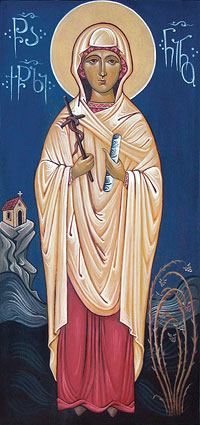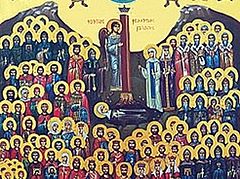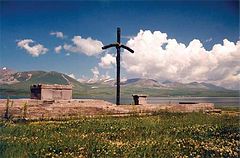
* * *
Christianity made man a new creation. It gave him the dignity of the image and likeness of God, and revealed an imperishable spiritual treasure. Christianity turned man’s thoughts and heart to eternity. It gave his soul the possibility to be reborn and resurrected through mystical experience. Christianity revealed to man the true freedom of love, instead of the pagan freedom of passions and tyranny. Christian theology gave an answer to the age-old questions raised but not answered by philosophy. The Gospel teaching showed that each human personality—inimitable and unique—is of supreme value. Christianity became a powerful impulse for rethinking and developing the relationships between people and nations, founded upon respect for man as an image of God and a manifestation of eternity on earth. The light brought by St. Nino illumined Georgia’s historical path for many centuries. The Baptism of Georgia was the beginning of a new era in the spiritual life of its people.
The Gospel was first preached in Georgia by the apostles themselves. It was like the first rays of the sun that brighten the mountain peaks, as if tearing them from the captivity of darkness and night. Ancient ice and snow burst into flames of blinding light, but in the gorges and passes the fog still curls like the black smoke of a campfire. The world is sunk in pre-dawn night and sleep. The peaks illuminated by the light were the first Christian communities founded by the apostles. But the people remained in pagan captivity. Apostles Andrew the First-Called, Simon the Canaanite, and Matthew had cast the seeds of Gospel teaching into Georgian soil, but three centuries passed before this land would be covered with wondrously beautiful flowers. Just as the Aragva River changes its flow from south to west at the borders of Mshkheta, so did the Baptism of Georgia in the Aragva turn Georgia’s entire course of history from Iran to Byzantium.
The fourth century was a time of conversion to Christianity in the Caucasus Mountain region. Georgia’s brothers, Armenia and Caspian Albania, also converted, and this Christian house became an impenetrable fortress against their enemies.
St. Nino was, according to ancient tradition, a cousin of Great-Martyr George the Trophy-Bearer. There is a great similarity between the image of the knight who slays the dragon and the young virgin, who raised the cross in her hands like a spiritual sun over Georgia.
Georgia is the portion of the Most Holy Theotokos. The Virgin Mary chose a virgin to be the apostle of Georgia—St. Nino, who was almost a child at the time. With the cross as her sword she was victorious in battle with paganism, and illumined the nation with the light of the Gospel. She captivated people’s hearts with the fire of love, which Christ had brought from heaven to earth. She converted the people to Christ not with artful words, but through the power of grace. Nino’s chosenness was marked by the gift of miracles and healing. But the conversion of a nation through a young virgin was the greatest miracle. It is impossible to prove the existence of light—it has to be seen. St. Nino herself was a bright lamp; those around her felt this light with their souls, and beheld the eternal beauty of the Gospels. They received Nino’s preaching as a new life, hitherto unknown to them.
St. Nino lived from her childhood in a Jerusalem church under the care of her uncle, Patriarch Juvenal. This church was located on the slopes of Mount Sion, where the Holy Spirit had descended upon the apostles (the Church of the Resurrection of Christ the Savior had not yet been built). St. Nino grew up under the eaves of the church, similar to how the Virgin Mary lived for ten years in the Old Testament temple in fulfillment of her parent’s vow. The Virgin Mary had access to the Holy of Holies. The virgin Nino prayed in the place where the Holy Spirit descended in the form of fiery tongues and founded the New Testament Church in the upper room on Sion.
Jerusalem is a book made of stone, written about Christ. There the air preserves the breath of His lips, and the earth, His footprints. There, it is as if time has stopped, and it seems that Christ is near, like the time of His earthly life.
St. Nino lived at the church, like a nun in reclusion. The church is a concentration of spiritual light. Outside the church the light becomes dispersed and dim. In the silence of the church she heard the voice of angels, and in visions she conversed with Christ the Savior, as St. Paul conversed face-to-face with Jesus in the Arabian Desert. The Mother of God appeared to her as she did to the apostles after her Dormition. She saw with her spiritual eyes the beginning and end of the world. Prayer transfigured her. The young virgin seemed to be the embodiment of the spirit of ancient prophetesses, or angels who had taken on human appearance.
At the Savior’s will and the Mother of God’s blessing, she came from Palestine to the capital of Georgia, Mshkheta, which became a second Jerusalem. The day of her arrival, August 6, was the New Year and festival of the Zoroastrian divinity Ahura Mazda—the main festival of fire-worshippers. St. Nino entered into combat with Ahura Mazda and conquered him, as St. George conquered the dragon. The dragon was slain by the power of prayer, and the idol of Ahura Mazda fell and shattered into dust. This day became the spiritual new year in the life of the Georgian people.
Mshkheta greeted St. Nino with festival noise, solemn processions, and a sea of fires lit to honor Ahura Mazda. For Mazdaists, every first day of the month was dedicated to Ahura Mazda, and this first day of the year was celebrated with particular solemnity. On the left bank of the Kura River, opposite Mshkheta, King Parnaoz built a fortress and a pagan temple called Armazi. On the left side opposite Mshkheta, on the mountain peak stood idols of the Zoroastrian divinity, wrought of metal and decorated with precious stones. One of them held a bared sword in an outstretched arm and stood over Mshkheta like a conqueror, looking over the city from the heights of a citadel.
St. Nino fell to her knees and began to pray that the Lord would cast down the idols with His might, just as the idols of Memphis shook and fell when the Virgin Mary and her Infant passed through the city gates.
A miracle occurred. A storm arose. The horizon was darkened by clouds as if the sky was furrowing its brow. Dark clouds like black glaciers flows over Mshkheta. The sun’s light turned to dusk, as if time was turning back and night was on again. Lightning tore the clouds. The whole earth seemed to shake from the thunder. A whirlwind like a tornado flung Ahura Mazda into the gorge, like a knight throws his combatant from his horse. Torrential rain poured down mixed with hail, like molten metal and stones cast from battlements. The water of the Aragvi became covered with foam, as if it was boiling—waves heaved upwards, as if they wanted to reach the mountain peaks. It seemed that the river would crash over Mshkheta and drown it in its belly. People ran to their homes in horror. The city emptied, like a graveyard. But the storm passed as quickly as it came. Again the sun shone in the sky cleansed by wind and washed by rain. On the mountain peak there were no longer any idols to be seen, as if St. Nino had torn the military emblem from the walls of the Acropolis. In the thunder and wind, in the blinding flashes of lightning a new page opened in the Christian chronicles of Georgia, magnificent as Caucasus nature.
St. Nino began to live in the house of the king’s orchard keeper, the Jew Anastasios. Here she built a hut out of branches covered with clay on the edge of the king’s orchard. Her bed was a piece of wool felt thrown over the earth in place of a carpet, on which she prayed most of the night, falling asleep just before daybreak. On this site is built the Samtavro Monastery of St. Nino. In her desert cell is the cross made of grapevines, given to her by the Virgin Mary. This cross, a great sacred treasure of Georgia, is kept in the Sion Cathedral in Tbilisi.
In the Greek Chronicles, St. Nino is called Nonna; that is, nun and recluse. For the heart of a monk, the desert is the place where he meets Christ. St. Nino often withdrew to the outskirts of Mshkheta, especially to the mountain that is now crowned with the Dzhvari church, where the noise of the city and waves of the river would not disturb her silence. In the mountains the quietude is like an impenetrable, transparent crystal wall. There she prayed for hours to God, and when the first stars appeared in the sky, like candles lit by an invisible hand before an iconostasis, she would descend to the capital city, where the houses’ windows glowed like stars fallen from the sky.
St. Nino’s preaching was accompanied by manifestations of God’s power, especially the healing of the sick. Through the Jews who had settled in the Caucasus by at least the seventh century before Christ, the peoples of Georgia had been acquainted with Biblical teaching. Christian communities founded by the apostles in as early as the first century formed separate islands that eventually turned into an archipelago, spreading across the sea of paganism. By the end of the third century, Christianity was the second religion in size after Mazdaism. Georgia now stood before a choice: what should it be from now on—pagan, or Christian; what should they choose—the Gospels or the Avesta, the light of the Cross or the fires of Zoroaster?
Queen Nana, who had been healed of a mortal disease by the virgin Nino, became a Christian. King Mirian, son of a Persian shah, had been taught from childhood that Iran was the land of light, and east and west of it was the kingdom of darkness—Turan and Rome. The priests of Zoroaster convinced the king that Christianity is the herald of catastrophes prophesied by Zoroaster, that it is the religion of women and slaves, not worthy of an Aryan, that the true faith would perish through a woman, as one Indian sage had written five centuries before the birth of Christ, that Iran was created by great heroes who had conquered the devs (giants) from Turan, and because of the Christians the Jews perished and Rome was in decline.
The king was sunk in heavy doubts.
Where is the truth? Where should he lead his people? Will his descendants bless, or curse his name? The scales of history wavered in his hands, and no one knew which cup would drop lower. But the king’s doubt was resolved by a miracle—he was saved from fatal danger when he called upon the unknown God of St. Nino. King Mirian became the first Christian king of Georgia. According to the Greek chronologists, Georgia’s conversion happened in 318 A.D., and the Baptism of Georgia according to the Kartlis Tskhovreba (Life of Georgia) happened in 326, while the time of the hierarchical establishment in the Georgian Church came in 337.
The priests and bishops sent from Byzantium baptized the people of Georgia and Aragva. The place where King Mirian and his princes were baptized is called to this day the “courtiers’ font”. Downstream on the river, like in an enormous font, the people were baptized.
The fires of Zoroastrianism were extinguished in the waters of the Aragva; in the waves of the Aragva the blood of human sacrifices spilled to idols before the reign of Reva the Righteous (two centuries B.C.) was cleansed away, as was the filth of pagan theurgy and magic. The shards of shattered idols were thrown like corpses in a common grave in the Aragva. The Holy Spirit descended into the waters of the Aragva, as it did into the waters of the Jordan.
St. Nino traversed all of Kartli and Kakhetia with her preaching. She ascended to mountain settlements that were like eagles’ nests clinging to cliffs over the abysses. She preached in the courts of princes and in the huts of paupers. Day and night she spent in care for the newly baptized people, like a godmother for her children.
Nino performed the ascetic labors of her life in the eastern region of Georgia called Ereti, in the settlement of Bodbe. Like a gravestone on her grave stands the Church of St. George the Trophy Bearer. Here St. Nino rests in body, but in spirit she abides in every church, city, and village of Georgia. She abides in the heart of Georgia, and Georgia, in her heart.



